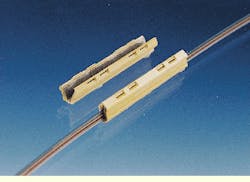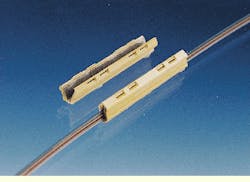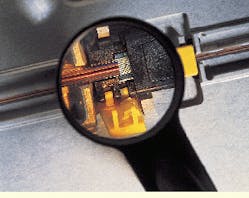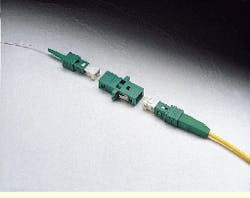Fusion splicing is preferred for bulk applications, but mechanical splicing holds its own.
Lynn Haber
When bulk-fiber applications in the outside plant were the only game in town, fusion splicing was the primary technology used to join optical fibers. But as fiber has approached the desktop and the number of fibers found in premises and campus locations increases, other forms of connectorization--namely, mechanical splicing and the use of fiber-optic connectors--are playing an increasingly important role in outside-plant installations.
Fusion splicing goes back a long way. In the 1970s, for example, it was the dominant optical-fiber splicing technology. However, fusion-splicing equipment has been considered expensive, temperamental, and easily affected by humidity and temperature, as well as difficult to use. "Fusion splicing not only required a very technical craftsman familiar with splicing," says Dan W. Silver, marketing development manager at 3M`s Telecom Systems Div. (Austin, TX), "but also someone who was familiar with using the telecommunications equipment."
Fusion splicers do just what the name implies: They fuse or melt together optical fibers. The fiber of 20 years ago--when fusion splicers were introduced--wasn`t the same as the fiber used today. Early singlemode fiber was not always well-aligned in the center of the core, for instance. As manufacturing processes have tightened fiber tolerances, it has gotten easier to make consistently low-loss fusion splices.
In the 1980s, while fusion splicing was improving in quality, mechanical splicing--which relies on a sleeve to hold the two fiber endfaces together--grew in popularity. Common practice in the cabling industry was to use fusion splicing on singlemode fiber because of the greater precision required, and to reserve mechanical splicing for larger-diameter multimode fiber, where the optical loss budget was typically more forgiving.
A milestone in fusion-splicing technology occurred when small, less-expensive devices were introduced in the late 1980s. Preformed Line Products Co. (plp--Cleveland, OH), for example, introduced a palm-sized splicer. According to Robert Whapham, plp communications product manager, the splicer weighed 2 pounds and was a quarter the price of the previous generation of fusion splicers--$6000 to $12,000 compared to $30,000 to $40,000. Many manufacturers of fusion splicers followed plp`s lead, and today at least a dozen vendors offer smaller products.
Despite profound changes in both optical-fiber and connectorization technology during the last two decades, fusion splicing remains popular today. It generates superior splice loss--about 0.02 decibel per splice almost 99% of the time, according to Casey B. Whitelaw, application/project engineer at Sumitomo Electric Lightwave Corp. (Research Triangle Park, NC). Also, over the past half-dozen years, fusion-splicing equipment that can handle multiple splices at one time has been introduced.
Overall, fusion splicers are easier to use and don`t have as steep a learning curve as that of earlier products. Microprocessor control, for example, both reduces cost and eases use. These and similar product changes encourage more cable installation companies to purchase the devices and train more technicians on the machines. Cable installers today tend to use fusion splicers in applications where a minimum loss budget is required, as well as when using ribbon cable, where the fusion splicer can quickly do 12 splices at one time. Fusion splicing also continues to be used in most singlemode applications and when a permanent splice is required.
Changes in protection covers
Once the fusion splice is made, it is typically protected by covering it with a plastic sleeve. Heat-shrink sleeves requiring the use of a warming oven are most often used today and take a couple of minutes to install after the oven warms. Fusion splicers were once sold with an oven, but today many fusion-splicer manufacturers sell the oven separately.
Changes in the technology of protection covers have accompanied the evolution of fusion-splicing technology. "We introduced a mechanical fusion splice protection cover that doesn`t require an oven," says Attila Huebscher, marketing director at Advanced Custom Applications (aca--Belle Mead, NJ). Why? Because in addition to the cost of the heat-shrink sleeve itself, an expensive oven, which can cost $1200 to $1500, must be purchased to install ordinary protection covers, according to Huebscher.
aca`s Ultrasleeve requires no heat-shrinking, curing, crimping, or gluing. The product`s plastic housing comprises two halves that fold along a hinge; the device is delivered in an open position. Once the fibers are placed in the protection cover, the sleeve is closed and locked, preventing the Ultrasleeve from being used again. One of the company`s fully mechanical fusion splice protectors can accept any combination of buffer sizes, ranging from 250- to 900-micron individual fibers and including up to 4-fiber ribbon cables. The product is available in 40- or 60-millimeter cover dimensions.
The latest no-heat sleeve protector from aca, introduced earlier this year, is called the masssleeve--a fully mechanical fusion splice protector that can accept 2- to 12-fiber mass or ribbon cable. It comes with a 40-mm cover. The product saves time and money because it does not require heating, curing, or gluing, and it eliminates the expense of a curing oven. Also, battery life and heating time for the oven do not need to be considered. Ultrasleeve and masssleeve are applied after the fusion process.
Mechanical splices hold their own
Mechanical splicing has always suited outside-plant connectorization, but its uses have usually been limited to repair and restoration work, splicing multimode fiber, applications where installers make only a few splices at a time, and in cases where the installer cannot afford the cost of more-expensive fusion splicing. "Mechanical splicing is particularly well-suited to restoration work--to get a system up and running in the shortest period of time," says 3M`s Silver. Cable technicians then routinely return to the mechanical-splice site at a later time and make a more permanent fusion splice.
A mechanical splice is quick--installation takes about 3 minutes--and doesn`t require much training or up-front capital investment. The average cost of a mechanical splice is about $7.95, according to manufacturers. Mechanical splices are available for both singlemode and multimode fiber.
Fibrlok from 3M, one of the earliest mechanical-splice products, was and still is popular among installers using this type of device, which is offered by a number of manufacturers today. "We and other manufacturers offer mechanical splices that perform comparably to other splicing methods," says Silver, who adds that product improvements and rigorous testing have boosted the performance of mechanical splices to almost that of fusion splices.
First-generation mechanical splices depended on glues and adhesives that sometimes failed and required installers to redo their work. But second-generation devices were truly mechanical and provided enhanced performance. Today, 3M`s Fibrlok family of mechanical splices includes single-fiber and multiple-fiber ribbon configurations and comes with all the tooling needed to do the installation, according to Silver.
A single Fibrlok splice costs $10 to $12, and multiple-fiber products are priced less per fiber. Although a mechanical splice doesn`t claim to produce zero attenuation, Silver states the 3M product has only about 0.1 dB of loss. "We developed a unique cleaver to produce good endface quality," Silver adds. The result is a consistent low level of loss across all fibers in a ribbon with a multiple-fiber mechanical splice. (With mechanical splicing, cleave quality is a critical factor, and installers need to work under good conditions to produce the lowest possible loss.)
Achieving such consistency when making fusion splices on 12 fibers, for instance, is trickier. "In a fusion splice," explains Silver, "you may get excellent loss on 8 fibers but more loss on the other 4."For cable installation companies that do a considerable amount of fiber-optic splicing, the capital cost of a fusion splicer can be absorbed readily. Following the up-front investment in splicing equipment, heat-shrink or no-heat sleeves cost only about 95 cents each. By comparison, a mechanical splice typically costs nearly $8.
Companies that offer mechanical splices once claimed that a splice is forever. No one talked about re-enterable splices. Today, 3M says that one of its mechanical splices can be reused a number of times. "A mechanical splice is re-enterable and reusable only up to 25 times," says Silver. Beyond that, the customer takes a big risk, he adds.
What has changed? According to Silver, after extensive age-and-performance testing and with field experience, the company is comfortable telling users that mechanical splices can be re-entered. "It`s something many installers did anyway," he adds. Before 3M did follow-up testing, the company was concerned that multiple re-entry of a mechanical splice would remove too much of the index-matching gel that coats the fibers. But testing has convinced 3M and other manufacturers that gel loss is minimal. "Additionally, the quality of fiber today is good, and the products hold their tolerances well," states Silver.
Fiber connectors find use in outside plant
The latest trend in outside-plant connectorization is the use of standard fiber-optic connectors. The trend, according to plp`s Whapham, seems to be growing but the procedure is not one that`s done routinely. "No engineer would purposely design connectors into the outside plant," Whapham adds. That being said, there are practical advantages to using connectors for this type of work.
At one time, for instance, fiber-optic cable was installed between points A, B, and C and was never touched again. Now, fiber is accessed at different points and times, which introduces a new requirement for flexibility.
"There`s more of a need today to reassign fibers in the outside plant and to have test points," says Whapham. This suggests the use of connectors in outside-plant closures for setting up crossconnects; breaking out fibers, and establishing test points. The connectors predominantly used are the ST, SC, and FC.
When time is limited, installers can reassign fibers quickly using connectors. "As soon as the technician opens a closure, the wires are there, and they`re numbered," explains Wapham. "He or she can unscrew the connector in less than a minute."
A comparable scenario with a fusion or mechanical splice only requires a couple of minutes, but because of the way fibers are stored in splice trays, as well as the typical situations with slack and routing, the time it takes to locate the individual splice being sought among a group of fibers must also be considered. And, for testing, it isn`t practical to break splices to make a test, not to mention that the test equipment itself is connectorized.
However, you can expect a loss budget of about 1 dB using connectors, which is more than 10 times higher than the loss of a mechanical splice. Connectors are also expensive; because it takes two connectors and a feed-through adapter to connect two fibers, the cost is about $30 per connection.
For all types of fiber-optic field installation, Molex Fiber Optics Inc. (Downers Grove, IL) sells the OptoClip II Connection System, a ferrule-less connector design. Terminations are performed without the use of epoxy and curing ovens, according to Molex product marketing manager Mike Mayscak. OptoClip II offers a push-pull connect/disconnect design with a positive locking mechanism similar to the standard SC`s. "Instead of aligning two ferrules," adds Mayscak, "we take the fibers themselves and get superior insertion loss," which amounts to about 0.1 dB--about the same as that of a mechanical splice.
Molex has offered this product line for several years and recommends it for applications such as data-communications networks, telecommunications networks, broadband deployment, crossconnects, cable-TV upgrades, locations using analog lasers, and outside-plant environments, such as optical network units, controlled-environment vaults, and huts.
Typical installation time for the OptoClip II is 2 to 3 min, according to Mayscak, and material cost is $17 to $18.50 for two connectors and an adapter.
Sumitomo Electric`s Whitelaw advises that when you are using connectors in an outside-plant application, it`s important to stick with quality connectors and use a ceramic rather than metallic ferrule, because it allows for expansion and contraction--that is, if the product of choice isn`t ferrule-less.
According to industry watchers, there is a growing preference for SC connectors in the outside plant because of the push-pull design and the fact that their small-footprint design allows them to be installed close together. Also, SC connectors are considered more environmentally robust.
Recognizing the need for more-flexible connectorization in the outside plant, Preformed Line Products has developed the Coyote closure--a single closure suitable for aerial, underground, buried, and in-building applications. The device is one step ahead of trends in outside-plant fiber optics and connect-orization, according to Whapham.
So, whether you are splicing or using connectors in the outside plant, the key to making the best product decision is to evaluate both the loss budget and the application.
masssleeve, aca`s fully mechanical no-heat sleeve protector for fu-sion splices, eliminates the need for a curing oven, can accept from 2- to 12-fiber mass or ribbon cables, and has a 40-millimeter cover.
Among second-generation mechanical splices is 3M`s Fibrlok, which can join single- and multiple-fiber ribbon configurations with losses consistently reported at just 0.1 dB.
Molex`s OptoClip II Connection System has a ferrule-less design. Terminations are made without using epoxy and curing ovens, with typical installation time estimated at 2 to 3 minutes for a wide array of applications.
Lynn Haber is a freelance writer specializing in networking and telecommunications issues.



